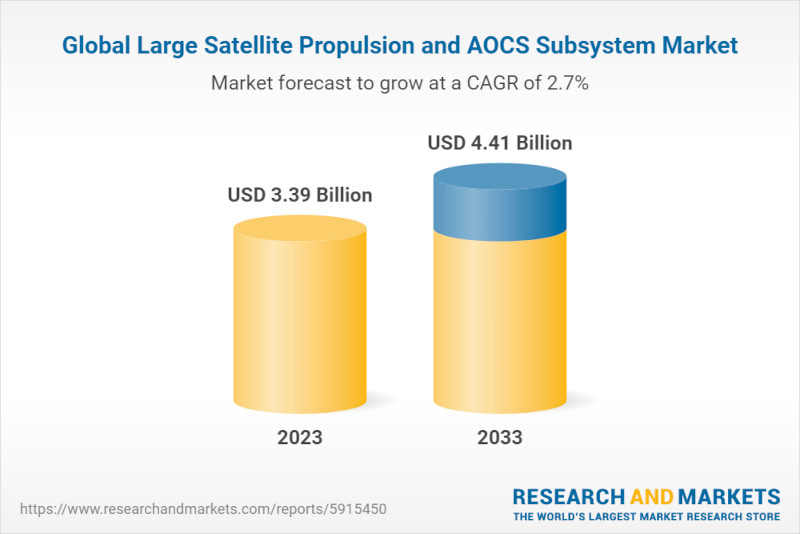Large Satellite Propulsion and AOCS Subsystem Market Through 2033
Innovation in Fuel Technologies Supports Market Growth
The global large satellite propulsion and AOCS subsystem market is estimated to reach $4.41 billion by 2033 at a CAGR of 2.66% during the forecast period 2023-2033, according to a new report from BIS Research.
According to The "Large Satellite Propulsion and AOCS Subsystem Market - A Global and Regional Analysis: Focus on Application, End User, Subsystem, and Region - Analysis and Forecast, 2023-2033", the ecosystem of the satellite propulsion and AOCS subsystem market comprises system manufacturers, original equipment manufacturers (OEMs), and end users. Over the past years, the number of small satellite constellations has increased tremendously, owing to the low cost associated with their development. Thus, it is fostering the market for propulsion systems in the forecast period 2023-2033.
The growing number of mega-constellations, which consist of hundreds or even thousands of connected satellites, is changing the approach by which satellites are deployed. These constellations are made up of multiple satellites that work together and are intended to deliver global broadband connection, transforming telecommunications on an unprecedented scale. Its primary objective is to bridge the technological gap by providing low-latency, high-speed internet connection in remote and distant areas. Large satellite constellations have the distinct benefit of being able to construct a wide network of linked satellites in low Earth orbit (LEO), considerably lowering signal travel time and increasing total communication speed. Companies at the forefront of this effort are utilizing modern technology, such as advanced signal processing and beamforming, to improve data transmission efficiency.
The scenario is further influenced by geopolitical considerations, with nations leveraging large satellites for strategic communication, surveillance, and national security. In November 2023, Maxar Space Systems announced that it had successfully handed over the operations of the large communication satellite JUPITER 3 to EchoStar. The satellite has 14 solar panels, allowing it to serve a wide range of high-bandwidth communications missions, including deep space missions such as NASA's PPE program, which is part of Gateway.
The industrial impact of advancements in large satellite propulsion and attitude and orbit control systems (AOCS) is profound, marking a significant evolution in space technology. These developments have extended the operational life of satellites due to the enhanced capabilities of propulsion systems that facilitate precise orbit placement and maintenance. This aspect is particularly crucial in sectors such as telecommunications and broadcasting, where consistent, long-term service is essential.
Furthermore, AOCS advancements have dramatically improved the precision and stability of satellites, ensuring accurate positioning and orientation. This precision is vital for critical applications such as earth observation, scientific research, and global navigation systems. The combination of advanced propulsion and AOCS technologies not only enhances the performance and reliability of satellites but also opens up new possibilities in space exploration and utilization, driving innovation across various industries.
The increasing demand for secure satellite communication infrastructure for the defense sector is a key driver of growth for the large satellite propulsion and AOCS subsystem market. Governments around the world are investing heavily in developing secure satellite communication networks to support their national security needs. These networks rely on large satellites that require high-performance propulsion and attitude control systems (AOCS) to maintain their orbits and provide reliable communication links.
As space exploration, AOCS satellite and satellite technology continue to advance, the issue of space pollution has become increasingly concerning. Space pollution refers to the accumulation of human-made debris in Earth's orbit, which poses a significant threat to the safe operation of satellites and spacecraft. To address this issue, there is a growing need for stringent regulations to control space pollution. Currently, there are several international guidelines and treaties that address space pollution, including:
Outer Space Treaty: This treaty prohibits the placement of nuclear weapons in orbit and calls for the avoidance of harmful interference with other states' peaceful exploration and use of outer space.
UN Space Debris Mitigation Guidelines: These guidelines provide recommendations for minimizing the creation of space debris during launch and satellite operations.
Kessler Effect: This concept highlights the potential for a chain reaction of collisions in orbit, leading to an exponential increase in debris and making it nearly impossible to operate satellites safely.
Advancements in satellite propulsion fuel technologies are driven by the need for more efficient, reliable, and environment-friendly propulsion systems. Traditional chemical propellants, such as hydrazine, are highly toxic and hazardous to handle, posing significant safety and environmental concerns. Advanced propulsion technologies, such as electric propulsion (EP) and hybrid propulsion (HP), offer promising alternatives to traditional chemical propellants, providing higher performance, longer lifespan, and reduced environmental impact.
The global large satellite propulsion and AOCS subsystem market comprises key players who have established themselves thoroughly and have the proper understanding of the market, accompanied by start-ups who are looking forward to establishing themselves in this highly competitive market. In 2022, the large satellite propulsion and AOCS subsystem market was dominated by established players, accounting for 90% of the market share, whereas start-ups managed to capture 10% of the market.
With the growing need for advanced defense capabilities and technological innovation, start-ups in the large satellite propulsion and AOCS subsystem market are expected to expand their presence and market share as they bring fresh perspectives and cutting-edge solutions to meet the demands of modern warfare.






